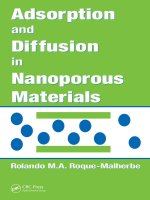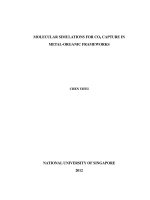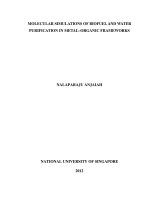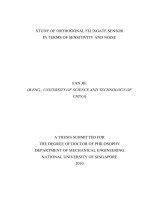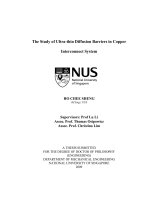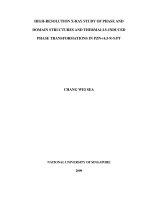Computational study of adsorption and diffusion in metal organic frameworks
Bạn đang xem bản rút gọn của tài liệu. Xem và tải ngay bản đầy đủ của tài liệu tại đây (8.18 MB, 268 trang )
COMPUTATIONAL STUDY OF ADSORPTION
AND DIFFUSION IN METAL-ORGANIC
FRAMEWORKS
BABARAO RAVICHANDAR
(M.Tech., NIT, India)
A THESIS SUBMITTED
FOR THE DEGREE OF DOCTOR OF PHILOSOPHY
DEPARTMENT OF CHEMICAL AND BIOMOLECULAR
ENGINEERING
NATIONAL UNIVERSITY OF SINGAPORE
2009
i
Acknowledgement
First of all, I would like to extend my sincerest and deepest gratitude to my supervisor
Prof. Jiang Jianwen. His constant help, stimulating suggestions and encouragement
from the initial to the final stage have enabled me to develop a good understanding of
the subject. His enthusiasm, positive outlook and belief in my abilities have helped
me go through the difficult phases of research.
I would like to extend my thanks to all the members in Prof. Jiang’s research group
for their invaluable suggestions, discussions and sharing of technical expertise since
the beginning of my PhD study. I also wish to thank Dr. Shaji Chempath for his help
during the initial phase of research. My special appreciation is due to Prof. Stanley I.
Sandler from the University of Delaware for his comments and suggestions on my
research papers.
I would also like to convey my thanks to Prof. Mario S. C. Mazzoni for kindly
providing the structure of covalent-organic framework nanotube. My appreciations
are due to Prof. Mohamed Eddaoudi and Prof. Yunling Liu for their helpful
discussions on the crystallographic structure of zeolite-like metal-organic
frameworks.
I would also like to express my sincere thanks to National University of Singapore for
providing me the research scholarship.
Finally, I am deeply indebted to my parents and my wife for their love, support and
encouragement during my PhD study.
ii
TABLE OF CONTENTS
ACKNOWLEDGEMENT…………………………………………………… i
TABLE OF CONTENTS…………………………………………………… ii
SUMMARY……………………………………………………………… vii
NOMENCLATURES………………………………………………………….x
LIST OF FIGURES……………………………………………………… xv
LIST OF TABLES……………………………………………………… xxiii
CHAPTER 1. INTRODUCTION …………………………………………… 1
1.1 Development of Metal-Organic Frameworks ……………………………1
1.2 Industrial Applications ………………………………………………… 12
1.2.1 Gas Storage ……………………………………………………. 13
1.2.2 Gas Separation ………………………………………………… 18
1.2.3 Catalysis ……… ……………………………………………… 21
1.3 Scope of the Thesis ……………………………………………………. 22
1.4 Organization of the Thesis …………………………………………… 24
CHAPTER 2. LITERATURE REVIEW ………………………………. 25
2.1 Single-Component Adsorption ……………………………………… 25
2.1.1 H
2
Storage …………………………………………………… 25
2.1.2 CH
4
Storage……………………………………………………. 31
2.1.3 CO
2
Storage……………………………………………………. 32
2.1.4 Other Gases……………………………………………………. 33
2.2 Multi-Component Adsorption ………………………………………… 35
2.3 Diffusion ……………………………………………………………… 38
iii
CHAPTER 3. SIMULATION METHODOLOGY………………………. 41
3.1 Interaction Potential …………………………………………………… 41
3.2 Monte Carlo …………………………………………………………… 43
3.2.1 Canonical Ensemble…………………………………………… 43
3.2.2 Grand Canonical Ensemble……………………………………. 45
3.2.3 Gibbs Ensemble ………………………………………………. 47
3.3 Molecular Dynamics ………………………………………………. …. 49
CHAPTER 4. ADSORPTION AND DIFFUSION OF CO
2
AND CH
4
IN
DIFFERENT TYPES OF NANOPOROUS MATERIALS…………… 52
4.1 Introduction …………………………………………………………… 52
4.2 Models………………………………………………………………… 54
4.3 Methodology…………………………………………………………… 60
4.4 Results and Discussion ……………………………………………… 64
4.4.1 Adsorption of Pure and Binary Components………………… 64
4.4.1.1 Limiting Properties …………………………………. 64
4.4.1.2 Adsorption Isotherms ………………………………. 65
4.4.1.3 Isosteric Heats of Adsorption……………………… 68
4.4.1.4 Adsorption Isotherms of Binary Components………. 71
4.4.2 Diffusion of Pure Components………………………………… 74
4.4.2.1 Diffusivities at Infinite Dilution………………………74
4.4.2.2 Self-diffusivities …………………………………… 76
4.4.2.3 Corrected-diffusivities ………………………………. 78
4.4.2.4 Transport-diffusivities ………………………………. 80
4.4.2.5 Correlation Effects ………………………………… 82
4.4.3 Diffusion of Binary Components……………………………… 86
4.4.3.1 Self-diffusivities…………………………………… 86
4.4.4 Permselectivity………………………………………………… 89
4.5 Summary………………………………………………………………. 91
iv
CHAPTER 5. STORAGE OF CO
2
IN METAL-ORGANIC AND
COVALENT-ORGANIC FRAMEWORKS……………………………… 94
5.1 Introduction……………………………………………………………. 94
5.2 Models………………………………………………………………… 95
5.3 Methodology…………………………………………………………… 104
5.4 Results and Discussion………………………………………………… 108
5.4.1 Adsorption in MFI, SWNT and MOFs………………………… 108
5.4.1.1 Structural and Limiting Properties………………… 108
5.4.1.2 Adsorption Capacities and Isosteric Heat…………… 110
5.4.1.3 Effect of Cations ……………………………………. 114
5.4.1.4 Adsorption Capacity in MOFs ……………………… 115
5.4.2 Adsorption in COFs…………………………………………… 118
5.4.2.1 Structural and Limiting Properties………………… 118
5.4.2.2 Adsorption Isotherms in COFs…………………… 119
5.4.3 Quantitative Assessment of CO
2
Storage in MOFs and COFs… 121
5.5 Summary……………………………………………………………… 123
CHAPTER 6. ADSORPTION SEPERATION OF CO
2
/CH
4
MIXTURES
IN METAL-ORGANIC FRAMEWORKS WITH UNIQUE
CHARACTERISTICS……………………………………………………. 126
6.1 Introduction……………………………………………………………. 126
6.2 Models ………………………………………………………………… 127
6.3 Methodology…………………………………………………………… 130
6.4 Results and Discussion………………………………………………… 131
6.4.1 Adsorption Isotherms………………………………………… 131
6.4.2 Adsorption Selectivity ………………………………………… 134
6.4.3 Effect of Electrostatic Interactions on Adsorption Selectivity… 136
6.4.4 Adsorption Isotherm and Selectivity in Charged MOF… 138
6.5 Summary………………………………………………………………. 139
v
CHAPTER 7. SEPARATION OF GAS MIXTURES IN ZEOLITE-LIKE
METAL-ORGANIC FRAMEWORK………………………………………. 142
7.1 Introduction……………………………………………………………. 142
7.2 Models ………………………………………………………………… 145
7.3 Methodology ………………………………………………………… 148
7.4 Results and Discussion………………………………………………… 151
7.4.1 Characterization of Na
+
Ions ………………………………… 151
7.4.2 Pure Gas……………………………………………………… 154
7.4.3 CO
2
/H
2
Mixture………………………………………………… 155
7.4.4 CO
2
/N
2
Mixture………………………………………………… 158
7.4.5 CO
2
/CH
4
Mixture and Effect of H
2
O ………………………… 159
7.5 Summary……………………………………………………………… 164
CHAPTER 8. ADSORPTION AND DIFFUSION OF ALKANE
ISOMER MIXTURES IN METAL-ORGANIC FRAMEWORKS…… 166
8.1 Introduction…………………………………………………………… 166
8.2 Models ………………………………………………………………… 168
8.3 Methodology ………………………………………………………… 171
8.4 Results and Discussion………………………………………………… 174
8.4.1 Adsorption ……………………………………………………. 174
8.4.2 Adsorption Selectivity………………………………………… 179
8.4.3 Diffusion ……………………………………………………… 182
8.5 Summary ………………………………………………………………. 186
CHAPTER 9. DRUG IN MESOPOROUS METAL ORGANIC
FRAMEWORK MIL-101……………………………………………………… 188
9.1 Introduction…………………………………………………………… 188
9.2 Models ………………………………………………………………… 190
9.3 Methodology ………………………………………………………… 193
9.4 Results and Discussion………………………………………………… 194
vi
9.4.1 Maximum Loading and Lowest Energy Conformation……… 194
9.4.2 Mobility of Ibuprofen …………………………………………. 198
9.5 Summary………………………………………………………………. 199
CHAPTER 10. CONCLUSIONS AND FUTURE WORK………………. 201
10.1 Conclusions ……………………………………………………………. 201
10.2 Future Work……………………………………………………………. 207
REFERENCES……………………………………………………………… 209
PUBLICATIONS ………………………………………………………… 238
PRESENTATIONS ………………………………………………………… 239
APPENDIX A ……………………………………………………………… 240
vii
Summary
Adsorption and diffusion in nanoporous materials lie at the heart of many large-
scale industrial applications such as gas separation, storage and selective catalysis. As
the number of nanoporous materials to date is extremely large, selecting a promising
material from discovery to applications is a challenge. The development of particular
technological applications for nanoporous materials requires the fundamental
understanding of their microscopic properties. In this sense, computational study
plays an important complementary role to experiments by making predictions prior to
experimental studies. The selection of a suitable adsorbent is a key step in the design
of adsorption-based storage or separation processes. While most studies have focused
on zeolites and carbon-based adsorbents, a new class of hybrid materials has been
recently developed, i.e. metal-organic frameworks (MOFs) which consist of metal-
oxide clusters and organic linkers. MOFs allow the formation of tunable porous
frameworks with a wide variety of architectures, topologies and pore sizes. Because
of their high porosity and well-defined pore size, MOFs are promising candidates for
the storage and separation of gases, ion-exchanges, catalysis, sensing, etc.
In this thesis, molecular simulation techniques such as Monte Carlo and molecular
dynamics have been used to elucidate the adsorption and diffusion phenomena of
fluids in a wide variety of MOFs.
(1) The adsorption and diffusion of CO
2
and CH
4
were examined in three different
nanoporous materials (silicalite, C
168
schwarzite, and IRMOF-1). IRMOF-1 has a
significantly higher adsorption capacity for CO
2
and CH
4
than silicalite and C
168
schwarzite, however the adsorption selectivity of CO
2
over CH
4
was found to be
similar in all the three adsorbents. The permselectivity was calculated based on the
adsorption and diffusion selectivity of the mixture, and found to be marginal in
viii
IRMOF-1, slightly enhanced in MFI, and greatest in C
168
schwarzite. Although
IRMOF-1 has the largest storage capacity for CH
4
and CO
2
, its selectivity is not
satisfactory.
(2) CO
2
storage in a series of MOFs was studied with different characteristics. In
addition, covalent-organic frameworks (COFs), a sub-set of MOFs were also
considered. Organic linker was revealed to play a critical role in tuning the free
volume and accessible surface area, and subsequently determines CO
2
adsorption at
high pressures. Due to low framework density and high porosity, COF-105 and COF-
108 exhibit the highest storage capacity among the adsorbents studied and even
surpass the experimentally reported highest capacity in MOF-177. COF-102 and
COF-103 are promising materials with high capacity at low pressures. The
gravimetric and volumetric capacity of CO
2
at a moderate pressure correlates well
with the framework density, free volume, porosity and accessible surface area of both
MOFs and COFs. These correlations are useful for a priori prediction of CO
2
capacity
and for the rational screening of MOFs and COFs toward high-performance CO
2
storage.
(3) The adsorption and separation of CO
2
/CH
4
mixture were studied in a series of
metal-organic frameworks (MOFs) with unique characteristics such as exposed metals
(Cu-BTC, PCN-6 and PCN-6), catenation (IRMOF-13 and PCN-6) and extra-
framework ions (soc-MOF). The framework catenation leads to constricted pores and
additional adsorption sites, and enhances the interaction with the adsorbate.
Therefore, catenated IRMOF-13 and PCN-6 exhibit a greater extent of adsorption,
particularly for CO
2
at low pressures compared to IRMOF-14 and PCN-6; however,
the opposite was observed to be true at high pressures. It was found that catenated
MOFs have a higher selectivity than their non-catenated counterparts. Much higher
ix
selectivity is observed in charged soc-MOF compared with other IRMOFs and PCN
structures.
For the first time, the extra-framework ions were characterized and gas separation
was examined in a charged MOF, rho-ZMOF, with anionic framework. In rho-
ZMOF, the presence of highly ionic framework enhances the CO
2
capacity at low
pressure and in turn increases adsorption selectivity. The selectivity was ~ 1800 for
CO
2
/H
2
, 80 for CO
2
/CH
4
, and 500 for CO
2
/N
2
mixtures. Compared with other MOFs
and nanoporous materials reported to date, rho-ZMOF exhibits unprecedentedly high
selective adsorption for gas mixtures.
(4) The effect of catenation on the separation of alkane isomers mixture was
simulated. Competitive adsorption between isomers was observed, particularly at high
pressures, in which a linear isomer shows a larger extent of adsorption due to
configurational entropy. It was found that both adsorption and diffusion selectivities
can be enhanced by catenation, particularly at low pressures.
(5) The microscopic properties of a model drug, ibuprofen, were studied in
mesoporous MIL-101 and UMCM-1 based on molecular simulation and first-
principle calculations. The loading capacity of ibuprofen in MIL-101 and UMCM-1 is
about four times greater than in MCM-41. A coordination bond between the
carboxylic group of ibuprofen and the exposed metal site of MIL-101 was observed.
In addition, ibuprofen exhibits a smaller mobility in MIL-101 than in UMCM-1 due to
strong interaction with the framework.
As a relatively new class of materials, MOFs will continue to attract extensive
interest in both academia and industry. They exhibit high potential for adsorptive
storage in energy applications as well as separation and purification in industrial
applications as illustrated in this thesis.
x
Nomenclature
collision diameter, Ǻ
B
/k
potential well depth, K
q
partial charge
N
ab,
<N>
absolute adsorption, mmol/g or mmol/cm
3
N
ex
excess adsorption, mmol/g or mmol/cm
3
T
temperature, K
V
volume of the system, cm
3
μ
chemical potential
V
total
total volume of the adsorbent, cm
3
U
ad,
U
total
total adsorption energy , kJ/mol
o
total
U
total adsorption energy of a single gas molecule , kJ/mol
U
intra
intramolecular energy , kJ/mol
int
o
ra
U
intramolecular energy of a single gas molecule , kJ/mol
k
B
boltzmann constant, 1.38066 10
-23
J/K
He
ad
u
interaction energy between helium and adsorbent, K
q
st
isosteric heat , kJ/mol
0
st
q
isosteric heat at infinite dilution , kJ/mol
K
H
Henry’s constant, mmol/g/kPa
ρ
b
bulk density, g/cm
3
f
fugacity, kPa
o
f
fugacity of pure component in standard state, kPa
N
i
maximum loading in site i, mmol/g
k
i
affinity constant
P
bulk pressure, kPa
y
mole fraction in gas phase
x
mole fraction in adsorbed phase
i
fugacity coefficient of component i
i
activity coefficient of component i
D(0)
diffusivity at infinite dilution, m
2
/s
xi
D
f
prefactor, m
2
/s
E
a
activation energy, kJ/mol
R
gas constant
D
s
self-diffusivity, kJ/mol
D
c
corrected-diffusivity, kJ/mol
D
t
transport-diffusivity, kJ/mol
thermodynamic factor
i
Ð
maxwell-stefan diffusivity, m
2
/s
θ
i
fractional loading of species i
i
loading of species i
,i sat
saturation loading of species i
corr
ii
Ð
self-exchange coefficient, m
2
/s
corr
ij
Ð
binary-exchange coefficient, m
2
/s
perm
S
permselectivity
diff
S
diffusion selectivity
sorp
S
sorption selectivity
f
framework density, g/cm
3
free
V
free volume of the adsorbent, cm
3
/g
porosity of the adsorbent
surf
A
surface area of the adsorbent, m
2
/g
S
selectivity
B
kk
bending constant , K/rad
2
o
equilibrium angle
internal
U
internal energy, K
external
U
external energy, K
bind
E
binding energy, kJ/mol
0
vib
E
zero-point vibrational energy at 0 K
0
elec
E
electronic energy at 0 K
xii
rot
E
rotational energy
trans
E
translational energy
g (r)
radial distribution function
t
time, ps
h
planck constant (6.62608 10
JS)
wt %
weight percentage
Abbreviations
SBU
Secondary Building Unit
MOF-n
Metal Organic Framework (with n an integer assigned in roughly
chronological order)
IRMOF-n
Isoreticular Metal Organic Framework (with n an integer referring to
a member of the series)
MIL-n
Materials of Institut Lavoisier (with n an integer assigned in roughly
chronological order)
UMCM
University of Michigan Crystalline Material
COF-n
Covalent Organic Framework (with n an integer assigned in roughly
chronological order)
ZIF-n
Zeolitic Imidazolate Framework (with n an integer assigned in
roughly chronological order)
TIF-n
Tetrahedral-Imidazolate Framework (with n an integer assigned in
roughly chronological order)
BIF-n
Boron-Imidazolate Framework (with n an integer assigned in roughly
chronological order)
ZMOFs
Zeolite-like Metal Organic Frameworks
TBUs
Tetrahedral Building Units
BDC
Benzene Dicarboxylate
BTC
Benzene Tricarboxylate
BPDC
BiPhenyl DiCarboxylate
PDC
Pyrene DiCarboxylate
DoE
Department of Energy
MMOFs
Microporous Metal Organic Materials
xiii
SWNT
Single Walled Carbon Nanotube
NOTT-nnn
NOTTingam (with nnn an integer assigned in roughly chronological
order)
PCN-n
Porous Coordination Network (with n an integer assigned in roughly
chronological order)
MC
Monte Carlo
MD
Molecular Dynamics
EMD
Equilibrium Molecular Dynamics
GCMC
Grand Canonical Monte Carlo
CB-GCMC
Configurational-Bias Grand Canonical Monte Carlo
GEMC
Gibbs Ensemble Monte Carlo
MP2
Møller-Plesset
TZVPP
Triple Zeta Valence Plus Polarization
QZVPP
Quadrupole Zeta Valence Plus Polarization
DFT
Density Functional Theory
LDA
Local-Density Approximation
GGA
Generalized Gradient Approximation
B3LYP
Becke’s three parameter, Lee, Yang and Parr
OPLS
Optimized Potential for Liquid Simulations
FF
Force Field
UFF
Universal Force Field
IAST
Ideal Adsorbed Solution Theory
UA
United Atom
AA
All Atom
LJ
Lennard-Jones
LB
Lorentz-Berthelot
MM
Molecular Mechanics
MMFF
Merck Molecular Force Field
AMBER
Assisted Model-Building with Energy Refinement
MS
Maxwell-Stefan
ESP
ElectroStatic Potential
RESP
Restrained ElectroStatic Potential
CHELPG
CHarges from ELectrostatic Potentials using Grid
xiv
TraPPE
Transferrable Potentials for Phase Equlibria
EoS
Equation of State
MUSIC
MUlti purpose SImulation Code
DSLF
Dual-Site Langmuir Freundlich
QENS
Quasi Electron Neutron Scattering
WMO
World Meterological Organization
IPCC
Intergovernmental Panel on Climate Change
MFI
Mobil FIve
ZSM-5
Zeolite Socony Mobil
MCM-41
Mobil Composition of Matter
1D,2D,3D
One-Dimension, Two-Dimension, Three-Dimension
soc
Square OCtahedral
ImDC
IMidazolate DiCarboxylate
D8R
Double eight Ring
S8R
Single eight Ring
FH
Feynman-Hibbs
PI
Path Integral
TIP3P
Three Point Transferable Interaction Potential
MSD
Mean Squared Displacement
ETS
Engelhard TitanoSilicate
IBU
IBUprofen
HOMO
Highest Occupied Molecular Orbitals
xv
LIST OF FIGURES
Figure 1.1
Single crystal x-ray structures of IRMOF-n (n=1 to 16). Color
scheme: Zn (blue polyhedra), O (red spheres), C (black
spheres), Br (green spheres in 2), amino-groups (blue spheres
in 3). The large yellow spheres represent the largest van der
Waals spheres that would fit in the cavities without touching
the frameworks. All hydrogen atoms have been omitted, and
only one orientation of disordered atoms is shown for clarity.
4
Figure 1.2
Number of metal–organic framework (MOF) structures
reported in the Cambridge Structural Database (CSD) from
1978 through 2006.
The bar graph illustrates the recent dramatic increase in the
number of reports, while the inset shows the natural log of the
number of structures as a function of time, indicating the
extraordinarily short doubling time for MOF structures
compared to the total number of structures archived in the
database.
5
Figure 1.3
Single-crystal structure of rho-ZMOF (left) and sod-ZMOF
(right). Hydrogen atoms and quest molecules are omitted for
clarity. In - green, C - gray, N - blue, O - red. The yellow
sphere represents the largest sphere that can be fit inside the
cage, considering the van der Waals radii.
12
Figure 3.1
Adsorbent in contact with a reservoir that imposes constant
chemical potential and temperature by exchanging particles and
energy. Equation of state to calculate the pressure of the gas.
45
Figure 3.2
Three types of move attempted in constant pressure-GEMC.
Volume changes only in the cell representing the bulk fluid.
48
Figure 4.1
Nano-sized channels in MFI, C
168
, and IRMOF-1. (a) MFI has
one straight channel and one zig-zag channel (b) C
168
has two
zig-zag channels. (c) IRMOF-1 has one straight channel.
55
Figure 4.2
Schematic representations of MFI, C
168
schwarzite and
IRMOF- 1.The structures are not drawn to scale their actual
sizes.
57
Figure 4.3
Atomic-centered partial charges in an IRMOF-1 cluster from
B3LYP/6-31g(d) computation. The cleaved clusters are
terminated by methyl group to maintain hybridization.
58
Figure 4.4
Schematic representation of united-atom model for CH
4
.
59
Figure 4.5
Schematic representation of three-site atom model for CO
2
.
59
xvi
Figure 4.6
Adsorption isotherms of CH
4
and CO
2
in MFI, C
168
, and
IRMOF-1 as a function of bulk pressure.
67
Figure 4.7
Isosteric heats of adsorption of pure CH
4
and CO
2
in MFI, C
168
,
and IRMOF-1. Legends are as in Figure 4.6.
69
Figure 4.8
Snapshots of pure CO
2
adsorption in MFI, C
168
, and IRMOF-1
at 500 kPa (top) and 2000 kPa (bottom).
70
Figure 4.9
Adsorption of an equimolar mixture of CH
4
and CO
2
in MFI,
C
168
, and IRMOF-1 as a function of bulk pressure. The filled
symbols are simulation results, and the lines are IAST
predictions.
72
Figure 4.10
Adsorption selectivity of an equimolar mixture of CH
4
and CO
2
in MFI, C
168
, and IRMOF-1 as a function of bulk pressure from
simulation. The dotted lines are to guide the eye.
73
Figure 4.11
Diffusivities D(0) at infinite dilution as a function of inverse
temperature for pure CH
4
and CO
2
in MFI, IRMOF-1 and
C
168
. Symbols are from simulation, and lines are the Arrhenius
fits to the symbols.
75
Figure 4.12
Self-diffusivities D
s
as a function of loading for pure CH
4
and
CO
2
in MFI, IRMOF-1 and C
168
. Symbols are from simulation
with dotted lines to guide the eye.
77
Figure 4.13
Corrected diffusivities D
c
as a function of loading for pure CH
4
and CO
2
in MFI, IRMOF-1 and C
168
. Symbols are from
simulation with dotted lines to guide the eye.
79
Figure 4.14
Thermodynamic factor
as a function of loading for pure CH
4
and CO
2
in MFI, IRMOF-1 and C
168
(the inset is for CO
2
in
IRMOF-1 at high loadings). Symbols are from simulation with
dotted lines to guide the eye.
81
Figure 4.15
Transport diffusivities D
t
as a function of loading for pure CH
4
and CO
2
in MFI, IRMOF-1 and C
168
. Symbols are from
simulation with dotted lines to guide eye.
82
Figure 4.16
Correlation coefficients
corr
ii i
Ð Ð
as a function of fractional
occupancy for pure CH
4
and CO
2
in MFI, IRMOF-1 and C
168
.
Symbols are predictions from simulated D
s
and D
c
using
equation eq. 4.10, and lines are the fits using the empirical
equation eq. 4.11.
84
Figure 4.17
D
s
, D
c
and D
t
as a function of loading for pure CH
4
and CO
2
in
MFI, IRMOF-1 and C
168
. Symbols are from simulation, and
lines are from MS formulation using eq. 4.10 for D
s
, eq. 4.12 or
4.13 for D
c
and eq. 4.9 for D
t
.
86
xvii
Figure 4.18
Snapshot of CH
4
and CO
2
mixture in MFI, IRMOF-1 and C
168
at a total loading of 3mmol/g. CH
4
: blue, C(CO
2
): purple,
O(CO
2
): yellow.
87
Figure 4.19
Self-diffusivities D
s
of CH
4
and CO
2
in MFI, IRMOF-1 and
C
168
as a function of total loading based on the adsorption of
equimolar mixture. Symbols are from simulation, and lines are
from MS formulation.
89
Figure 4.20
Diffusion selectivity of CO
2
over CH
4
in MFI, IRMOF-1 and
C
168
as a function of total loading based on the self-diffusivity
of equimolar mixture. Dotted lines are to guide the eye.
91
Figure 4.21
Permselectivity of CO
2
over CH
4
in MFI, IRMOF-1 and C
168
as
a function of total loading based on the adsorption of equimolar
mixture. Dotted lines are to guide the eye.
92
Figure 5.1
Schematic tailoring the metal oxide and organic linker in
IRMOF1. Zn: green, Mg: cyan, Be: purple, O: red, N: blue, C:
ash, H: white.
99
Figure 5.2
Atomic structures of COF-102, COF-103, COF-105, COF-108,
COF-6, COF-8, COF-10 and COF_NT. The structures are not drawn
to scale. B:pink, C: grey, O: red, Si: cyan, H: white.
100
Figure 5.3
Atomic charges in MOFs and COFs. Different cluster models
are used in density-functional theory calculations for MOFs
and COFs. The cleaved clusters are terminated by methyl
group to maintain correct hybridization.
103
Figure 5.4
(Left) Gravimetric and volumetric (in the inset) isotherms of
CO
2
adsorption in MFI, SWNT and IRMOF1 as a function of
bulk pressure. The lines are simulation results and the symbols
are experimental data.[2,4] (Right) Heats of CO
2
adsorption in
MFI, SWNT and IRMOF1 as a function of loading.
111
Figure 5.5
Gravimetric isotherms of CO
2
adsorption in IRMOF13 and
IRMOF14 from simulations. The solid and dotted lines refer to
adsorption with and without charges in the frameworks,
respectively. Inclusion of the framework charges leads to a
slightly higher adsorption.
112
Figure 5.6
Density distribution contours for the center-of-mass of CO
2
molecules in MFI, SWNT and IRMOF1 at 1000 kPa.
113
Figure 5.7
Isotherms of CO
2
adsorption in MFI, Na-ZSM-5 (23) and Na-
ZSM-5. The lines are simulation results and the symbols are
experimental data.
114
xviii
Figure 5.8
Gravimetric (left) and volumetric (right) isotherms of CO
2
adsorption in IRMOF1, Mg-IRMOF1, Be-IRMOF1, IRMOF1
(NH
2
)
4
, IRMOF10, IRMOF13, IRMOF14, UMCM-1, F-MOF1
and COF102.
116
Figure 5.9
Gravimetric (left) and volumetric (right) isotherms of CO
2
adsorption in COF-102, COF-103, COF-105, COF-108, COF-
6, COF-8, COF-10 and COF_NT at 300 K. Symbols are from
simulation and the lines are to guide the eye.
120
Figure 5.10
Density distribution contours for the center-of-mass of CO
2
molecules in COF-108, COF_NT and COF-6 at 1000 kPa.
121
Figure 5.11
CO
2
capacities at 30 bar as a function of (a) framework density
(b) free volume (c) porosity (d) accessible surface area. Solid
circles and curves: gravimetric capacity, open circles and
dashed curves: volumetric capacity.
123
Figure 6.1
Atomic structures of (a) IRMOF-1 (b) IRMOF-14 (c) IRMOF-
13 (d) Cu-BTC (e) PCN-6 (f) PCN-6 (g) soc-MOF. N: Blue,
C: grey, O: red, Zn: cyan, H: white, Cu and In: orange. The
structures are not drawn to scale.
128
Figure 6.2
Fragmental clusters used in the B3LYP/6-31g(d) calculations
for IRMOF-1, IRMOF-14, IRMOF-13, Cu-BTC, PCN-6,
PCN-6 and soc-MOF. To maintain the correct hybridization,
the dangling bonds on all the fragmental clusters were
terminated by -CH
3
.
129
Figure 6.3
Adsorption isotherms of the CO
2
/CH
4
mixture in (a) IRMOF-1
(b) IRMOF-14 and IRMOF-13 (c) Cu-BTC (d) PCN-6 and
PCN-6. Upward triangles: CO
2
and downward triangles: CH
4
.
In the legend, “C” denotes that framework charges were used
in the simulations.
132
Figure 6.4
Simulation snapshots of the CO
2
/CH
4
mixture at pressures (a)
100 kPa (b) 300 kPa (c) 1000 kPa in Cu-BTC (top) and (d) 300
kPa (e) 1000 kPa (f) 3000 kPa in PCN-6 (bottom). Cu: green,
O: red, C: cyan, N: pink, H: white; CH
4
: orange; CO
2
: purple
for C and yellow for O.
133
Figure 6.5
Adsorption selectivity of the CO
2
/CH
4
mixture in (a) IRMOF-
1, IRMOF-13 and IRMOF-14 (b) Cu-BTC, PCN-6 and PCN-
6.
135
Figure 6.6
Effect of framework charges on the adsorption isotherms of the
CO
2
/CH
4
mixture in (a) IRMOF-1 (b) IRMOF-13 (c) IRMOF-
14 (d) Cu-BTC (e) PCN-6 (f) PCN-6. The open (closed)
symbols indicate the isotherms in the presence (absence) of
framework charges. Upward triangles: CO
2
and downward
136
xix
triangles: CH
4
.
Figure 6.7
Effect of framework charges on the adsorption selectivity of
the CO
2
/CH
4
mixture in (a) IRMOF-1 (b) IRMOF-13 and
IRMOF-14 (c) Cu-BTC (d) PCN-6 and PCN-6. The open
(closed) symbols indicate the selectivity in the presence
(absence) of framework charges.
137
Figure 6.8
(a) Adsorption isotherms (b) Selectivity of the CO
2
/CH
4
mixture in soc-MOF.
139
Figure 7.1
(a) A unit cell of rho-ZMOF constructed from the experimental
crystallographic data. The extraframework ions are not shown.
Color code: In, cyan; N, blue; C, ash; O, red; and H, white.
146
Figure 7.2
Atomic charges in a fragmental cluster of rho-ZMOF
calculated using density functional theory.
147
Figure 7.3
(a) Binding sites of Na
+
ions in rho-ZMOF. Site I (green) is in
the single eight-membered ring (S8R), while site II (orange) is
in the -cage. (b) The central S8R is enlarged for clarity. Color
code: In, cyan (S8R); In, pink (D8R); N, blue; C, ash; O, red;
and H, white.
152
Figure 7.4
Radial distribution functions (a) between Na
+
ions and indium
atoms (b) between Na
+
ions and oxygen atoms.
153
Figure 7.5
Mean-squared displacements of Na
+
ions in rho-ZMOF.
154
Figure 7.6
(a) Adsorption isotherm (b) Selectivity for CO
2
/H
2
mixture
(15:85).
156
Figure 7.7
Density distribution contours of CO
2
molecules and Na
+
ions
for CO
2
/H
2
mixture (15:85) at 10, 100 and 1000 kPa,
respectively.
157
Figure 7.8
(a) Adsorption isotherm (b) Selectivity for CO
2
/H
2
mixture
(15:85). The charges on framework and extraframework ions
were switched off.
157
Figure 7.9
(a) Adsorption isotherm (b) Selectivity for CO
2
/N
2
mixture
(15:85).
159
Figure 7.10
Radial distribution functions between Na
+
ions and adsorbate
molecules for CO
2
/N
2
mixture (15:85) at 10, 100 and 1000 kPa.
159
Figure 7.11
Locations of CO
2
molecules for CO
2
/CH
4
mixture (50:50) in
the S8MR at 10, 500 and 3000 kPa, respectively. Na
+
ions and
CO
2
molecules are represented by balls and sticks. The
distances of C
CO2
-C
CO2
(orange) and Na
+
-O
CO2
(green) are in
160
xx
angstroms.
Figure 7.12
Radial distribution functions between Na
+
ions and adsorbates
for CO
2
/CH
4
mixture at 10, 500 and 3000 kPa.
161
Figure 7.13
(a) Isotherms and (b) selectivity for CO
2
/CH
4
and
CO
2
/CH
4
/H
2
O mixtures in rho-ZMOF. The bulk composition is
50:50 for CO
2
/CH
4
, and 50:50:0.1 for CO
2
/CH
4
/H
2
O.
162
Figure 7.14
Locations of CO
2
and H
2
O molecules in the S8R for
CO
2
/CH
4
/H
2
O mixture at 500 kPa. Na
+
ions are represented by
balls, CO
2
and H
2
O molecules are represented by sticks. The
distances of Na
+
-O
CO2
are in angstroms.
164
Figure 7.15
Radial distribution functions between Na
+
ions and adsorbates
for CO
2
/CH
4
/H
2
O mixture at 500 kPa.
164
Figure 8.1
Atomic structures of IRMOF-14, IRMOF-13, PCN-6’ and
PCN-6. Zn: cyan polyhedra, O: red, N: blue, C: grey, H: white,
Cu: orange polyhedra.
169
Figure 8.2
Adsorption isotherms of nC
4
/iC
4
mixture in IRMOF-14,
IRMOF-13, PCN-6’ and PCN-6. The insets are in the log-log
scale for the clarity of isotherm inflection. The circles are in
IRMOF-14 and PCN-6’; the triangles are in IRMOF-13 and
PCN-6.
175
Figure 8.3
Density contours of nC
4
isomer in IRMOF-14 at 1, 10, and 100
kPa.
177
Figure 8.4
Density contours of nC
4
isomer in IRMOF-13 at 0.1, 1, and 10
kPa, respectively.
177
Figure 8.5
Density contours of nC
4
in PCN-6’ at 10, 50, and 100 kPa.
Brighter color indicates a higher density.
178
Figure 8.6
Density contours of nC
4
in PCN-6 at 0.1, 1, and 10 kPa.
Brighter color indicates a higher density.
178
Figure 8.7
Adsorption isotherms of nC
5
/iC
5
/neoC
5
mixture in IRMOF-14,
IRMOF-13, PCN-6’ and PCN-6. The circles are in IRMOF-14
and PCN-6’; the triangles are in IRMOF-13 and PCN-6.
179
Figure 8.8
Selectivity of nC
4
/iC
4
and nC
5
/iC
5
/neoC
5
mixtures in IRMOF-
14, IRMOF-13, PCN-6’ and PCN-6. The circles are in IRMOF-
14 and PCN-6’; the triangles are in IRMOF-13 and PCN-6. The
lines are the best fits to the simulation results.
180
Figure 8.9
Mean-squared displacements of nC
4
and iC
4
in PCN-6’. The
insets are log-log plot.
182
xxi
Figure 8.10
Mean squared displacement of C
4
isomer mixtures in PCN-6.
The insets are log-log plot for MSD.
183
Figure 8.11
Diffusivities of nC
4
/iC
4
mixture in IRMOF-14 and IRMOF-13.
183
Figure 8.12
Diffusivities of nC
4
/iC
4
mixture in PCN-6’ and PCN-6. The
dotted lines are for visual clarity.
184
Figure 8.13
Diffusivities of nC
5
/iC
5
/neoC
5
mixture in PCN-6’ and PCN-6.
The dotted lines are for visual clarity
185
Figure 9.1
A unit cell of MIL-101 constructed from experimental
crystallographic data [419]. The pentagonal and hexagonal
windows are enlarged for clarity. Color code: Cr, orange
polyhedra; C, blue; O, red; H, white.
190
Figure 9.2
(a) A microporous cage constructed from six BDC linkers, five
BTB linkers, and nine Zn
4
O clusters. (b) Supercell of UMCM-
1 viewed along the c axis showing the one-dimensional
mesopore. Color code: Zn, green polyhedra; C, ash; O, red; H,
white.
191
Figure 9.3
Atomic charges in the fragmental clusters of MIL-101 and
UMCM-1 calculated from density-functional theory. The
cleaved bonds (indicated by circles) were terminated by methyl
groups to maintain the original hybridization.
192
Figure 9.4
(a) Lowest-energy conformation of IBU in MIL-101 from
simulated annealing (b) Enlarged view for the location of IBU
near the Cr
3
O metal-oxide in MIL-101. (c) Optimized
conformation of IBU near the Cr
3
O metal-oxide in MIL-101.
The distances are represented in angstroms. MIL-101: Cr,
orange; C, grey; O, red; H, white. IBU: C, cyan; O, pink; H,
purple.
195
Figure 9.5
(a) Lowest-energy conformation of IBU in UMCM-1 from
simulated annealing (b) Enlarged view for location of IBU near
the metal oxide in UMCM-1. (c) Optimized conformation of
IBU near the metal oxide in UMCM-1. The distances are
represented in angstroms. Color codes: UCMC-1: Zn, green; C,
ash; O, red; H, white; and Ibuprofen: C, cyan; O, pink; H,
purple.
196
Figure 9.6
Highest-occupied molecular orbitals in IBU/MIL-101 and
IBU/UMCM-1 complexes. A coordination bond is formed
between the carboxylic group in IBU and the Cr
3
O metal oxide
in MIL-101.
197
xxii
Figure 9.7
Optimized conformations of IBU in (a) vacuum (b) MIL-101
(c) UMCM-1. Color code: C, cyan; O, pink; H, purple.
198
Figure 9.8
Mean-squared displacements of IBU in MIL-101 and UMCM-
1. The inset is in the logarithmic scale.
199
xxiii
LIST OF TABLES
Table 4.1
LJ and Coulombic potential parameters for MFI, C
168
and
IRMOF-1.
57
Table 4.2
LJ and Coulombic potential parameters for CH
4
and CO
2
.
60
Table 4.3
Density and Porosity of MFI, C
168
, and IRMOF-1. Limiting
Adsorption Properties of Pure CH
4
and CO
2
.
65
Table 4.4
Parameters in the Dual-Site Langmuir-Freundlich Equation
fitted to Adsorption of pure CH
4
and CO
2
.
67
Table 4.5
Diffusivities D(0) at 300 K (10
8
m
2
/s), Prefactors D
f
(10
8
m
2
/s), and Activation Energies E
a
(kJ/mol) at Infinite Dilution
for CH
4
and CO
2
in MFI, C
168
and IRMOF-1.
76
Table 4.6
Saturation Loadings
,i sat
(mmol/g), Adjustable Parameters
i
and
i
in Eq. 11 for CH
4
and CO
2
in MFI, C
168
and IRMOF-1.
83
Table 5.1
LJ and Coulombic potential parameters for ZSM-5, SWNT,
MOFs and COFs.
101
Table 5.2
Framework density, free volume, porosity, accessible surface
area, Heat of adsorption and Henry constant calculated from this
work
in MFI, SWNT and MOFs.
109
Table 5.3
Framework density
f
, free volume V
free
, porosity
, accessible
surface area A
surf
, heat of adsorption
0
st
q
and Henry constant
K
H
in COFs.
119
Table 6.1
Atomic charges on the fragmental clusters shown in Figure 6.2
129
Table 7.1
Force field parameters for extraframework ions and adsorbates.
148
Table 7.2
Isosteric Heats and Henry Constants for CO
2
, CH
4
, H
2
, and N
2
in rho-ZMOF.
155
Table 8.1
Force field parameters for alkanes.
171
1
Chapter 1
Introduction
1.1 Development of Metal-Organic Frameworks
Porous materials are of scientific and technological interest because of their ability
to interact with atoms, ions and molecules not only at their surfaces, but also
throughout the bulk region. The applications of porous materials thus involve storage,
separation, ion exchange, catalysis, etc. Many of these benefit from the pore structures
in the materials. The pores are classified according to their sizes: pore sizes in the
range of 2 nm and below are called micropores, those in the range of 2 nm to 50 nm
are mesopores, and those above 50 nm are macropores. The pore sizes, shapes and
volumes in porous materials directly govern their ability for desired function in a
particular application. For example, a material with uniform micropores such as
zeolite can separate molecules on the basis of their sizes by selectively sieving small
molecule from large one [1]. However, inorganic zeolites exist in limited number of
structures because of the difficulty in tuning tetrahedral building blocks.
Recently a different approach to prepare porous solids involves the coordination
of metal ions to organic „linker‟ moieties, thus yielding open framework structures. In
fact, these materials have a long history and the earlier examples include transition
metal cyanide compounds (Hofmann-type clathrates, Prussian-Blue type structures
and Werner complexes). The open frameworks comprising metal–organic units
gained renewed considerable interest in 1990s, but the inability of these solids to
maintain permanent porosity and avoid structural rearrangements upon guest removal
or guest exchange has been a shortcoming [1]. However, metal–organic frameworks
